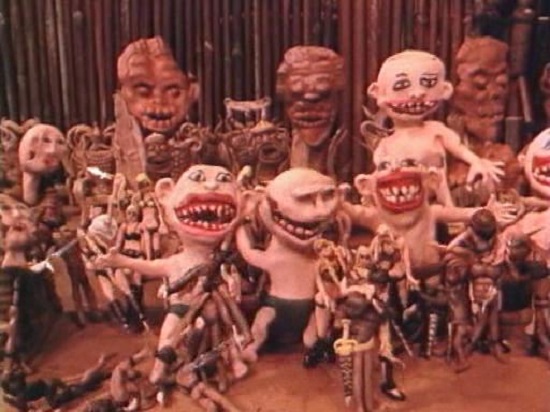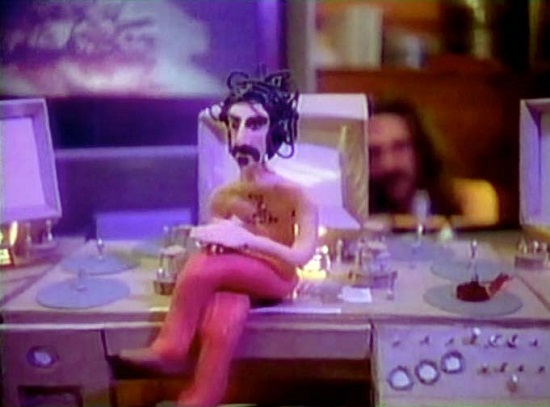"One of the worst films in the entire history of cinema, a criticism I can confidently assert since I was responsible, in part, for its direction."
The above quote appeared in Tony Palmer’s music column for the Observer on November 7th, 1971. He’d been tasked with reviewing the 200 Motels soundtrack but couldn’t resist putting the boot into a film he’d completed mere months before (and was due to open in British cinemas just three days later). For Palmer it would be "a dreadful moment from my past" for years to come, an opinion that would only change during the prep for a DVD edition in 2009. Although perhaps soften would be the better term, given that he still finds much of it nonsensical and over-egged.
To be fair to Palmer, 200 Motels was never really his film. Despite credits as both co-writer and co-director, his role was essentially that of facilitator to the real creative talent. This was a Frank Zappa movie, albeit with Palmer in place as the man with filmmaking experience. Alongside his role as one of the Observer‘s music critics, he’d also spent the previous few years making documentaries for the BBC, including the record of Cream’s farewell concert at the Royal Albert Hall and the countercultural survey All My Loving, on which he first met Zappa. His job, in effect, was to supply some technical know-how as well as shaping the material into something resembling a coherent narrative.

The success rate of the latter is open to debate, but then 200 Motels was suitably unconventional in its origins. The title reflects life on the road, offering up a rough estimation as to how many of these lodgings Zappa and the Mothers of Invention had made use of over the past few years. Its first use was in naming an orchestral suite that would make its debut at UCLA in 1970. Zubin Mehta and the Los Angeles Philharmonic were employed for the sell-out concert, with the Mothers providing a few numbers in between pieces. It proved successful enough that Zappa envisioned a television special, possibly for Dutch broadcaster VPRO, which would combine band, orchestra and a maybe a fantasy sequence or two.
Palmer’s involvement prompted the expansion to full-blown feature film. He’d demonstrated some of the then-burgeoning video technology to Zappa, who found it cheap and easy enough to justify a larger-scale production. More importantly, United Artists felt the same way and so stumped up the budget as well as securing the rights for any soundtrack releases. 200 Motels was made in a little over a week, courtesy of a Pinewood Studios soundstage and a four-camera set-up. During that time it housed Zappa, the Mothers of Invention, the Royal Philharmonic Orchestra and a collection of actors and/or oddballs who would supply the ‘drama’. The entire thing was captured on videotape, edited in-camera for the most part and then converted to 35mm film for cinema projection.
"Touring can make you go crazy. And that’s what 200 Motels is about." The nearest viewers get to an explanation comes at the very start of the picture. The fact that it’s delivered by Ringo Starr, dressed like Zappa (complete with signature facial hair) but named Larry the Dwarf, tells you all you need to know about its seriousness. In effect, Larry is a Zappa surrogate, while various Mothers old and new – plus a handful of groupies – play themselves. Oscar-nominee and folk singer Theodore Bikel also puts in an appearance, as do Keith Moon and Ringo’s chauffeur, while Wilfrid Brambell (aka Old Man Steptoe) was due to cameo but got scared off when he visited the set.
The dramatic scenes revolve around the fictional town of Centerville, the latest stop-off point on the Mothers’ current tour and "a real nice place to raise your kids up". Their arrival prompts a succession of skits, sketches and loose recreations of Zappa’s own experiences on the road intermingled with musical numbers, the orchestral pieces and other digressions. All of this co-exists on that same single soundstage which belies its TV special origins: cameras switch abruptly from one side of the studio to the other; the Royal Philharmonic sit patiently as band members goof around and groupies strip off; Keith Moon, most likely bored in between his own scenes, runs around interrupting takes.

Moon’s presence, not to mention that of Starr, points up the slapdash nature of it all. The pair would later co-star in Son Of Dracula (which combined a pair of Nilsson albums with comedy-horror) to similarly self-indulgent effect, plus Ringo was only a year away from directing Born To Boogie, the T. Rex concert movie that also functioned as a curiously unfunny sketch show. They could co-exist in a movie to fine effect – look no further than That’ll Be The Day – but that’s not the case here. 200 Motels is a mess, though clearly an intriguing one. It has cult credentials coming out of its ears and so, inevitably, found itself a home at midnight screenings and played the BBC’s Moviedrome strand during Alex Cox’s tenure.
Neither Palmer nor Zappa would replicate 200 Motels‘ unique blend. Palmer turned his back on the whole affair, not just with his disparaging comments in the Observer, but also by sticking to a more conventional filmmaking approach. Straightforward documentary portraits become the norm, his subjects ranging from Liberace to Ginger Baker. Rare forays into fiction, meanwhile, focused on long-dead composers (Wagner, Shostakovich) and were more readily influenced by Ken Russell, for whom Parker had worked briefly in the mid-60s. Zappa, on the other hand, wouldn’t direct again for almost a decade, eventually re-emerging as a filmmaker with a concert movie in 1979.
Proclaiming itself "a movie about people who do stuff that is not normal", Baby Snakes took the best part of three hours to document a Halloween gig from two years previous. Part of the reason for the delay was a general lack of interest in Zappa from the major studios, though the running time surely didn’t help matters. Self-indulgence (200 Motels lived on in that respect) meant self-distribution, yet Zappa would ultimately turn this to his advantage. He’d begun to release his albums independently, following a dispute with Warner Records, and would soon set up a lucrative mail order business. The film side, entitled Honker Home Video, once again demonstrated his interest in video technology and would see various tapes issued throughout the 80s. These were mishmash affairs combining concert footage with interviews, promos and others bits of business. Video From Hell, for example, found room for home movie footage, an outtake from 200 Motels, clips from the abandoned Uncle Meat film, the banned-by-MTV music video to ‘You Are What You Is’, and plenty more besides.
The key VHS was The Amazing Mr. Bickford, an hour-long compilation devoted to animator Bruce Bickford. Zappa had first demonstrated his interest in the form when he provided the soundtrack for a cartoon cough mixture commercial in 1967. Later on he would put in guest star appearances on episodes of The Ren And Stimpy Show and Duckman, plus there were aborted plans to cameo in The Simpsons and a never-realised project with Terry Gilliam. He’d also snuck a 10-minute short into 200 Motels, entitled Dental Hygiene Dilemma, which was later spun-off into Down And Dirty Duck, a cult feature in its own right. But none of these was quite so important to Zappa as Bickford; indeed, the young animator was shipped from his Seattle basement to Zappa’s base in L.A. and bankrolled for the best part of a decade, even though very little work actually saw the light of day.

Bickford was a Vietnam veteran whose love for animation sprung out his crude home movies. His earliest experiments involved toy cars, but a need to populate these rough little films led to the creation of tiny clay figures. Soon enough he was letting his imagination spill out with strange, ever-morphing stream of consciousness tales that seemed to revolve around demons and animal heads, hamburgers and pizzas, treacherous landscapes and excessive violence – "danger and weirdness", in Bickford’s own words. Audiences were given an early taste when The Old Grey Whistle Test aired a portion of ‘City Of Tiny Lights’ with animated accompaniment in 1979. Baby Snakes made its debut during the Christmas of that year, containing more examples and a peak of behind-the-scenes amidst the concert footage.
"I can’t explain it right off-hand," Bickford offers when pressed by Zappa as to what a particular film is all about. His work tends to mutate rather than progress, more often than not resembling a made-up-on-the-spot children’s story (and then this happened… and then this happened… and then this happened…). One of the Baby Snakes snippets involves a castle that "would make a great disco" but leads to the creation of monsters. It doesn’t make a great deal of sense, though maybe that’s missing the point. The immediacy is what matters, and the fact that these films have the potential to go absolutely anywhere from one moment to the next. They are also clearly the product of a single mind (and single-mindedness), despite Zappa nabbing director credits on The Amazing Mr. Bickford compilation and the ‘City of Tiny Lights’ promo. In a way, Bickford is an outsider artist doing his own thing at his own pace, and was simply fortunate enough to have Zappa serve as a momentary sugar daddy.
Such are the working methods and approach to narrative that very little final product has actually been released. The Amazing Mr. Bickford and Baby Snakes made use of snippets with little or no attempt to explain or understand; they unfold beneath Zappa instrumentals and just exist, nothing more. Bickford returned to his Seattle basement in 1980 and has carried on obsessing ever since. MTV commissioned some idents and a half-hour film, Prometheus’ Garden, was completed in 1987, but otherwise he toils away with seemingly little end in sight. Documentary portrait Monster Road (from 2004) showed him working on the stroke of midnight one New Year’s Eve, seemingly happiest in his own company. "I’m afraid of life," he admits in Baby Snakes, preferring to find an outlet in his animation instead.
Despite these mere glimpses he’s given us over the years (with further snippets popping up on DVDs or his official website), Bickford represents Zappa’s true cinematic legacy. 200 Motels may be a one-of-a-kind movie, but that isn’t necessarily a good thing given its mix of the awful and the inspired. The discovery of Bickford, however, would lead him to the real deal: films that look and feel like no other, derived from an utterly singular talent. It’s just a shame that there is so little out there to see. The Amazing Mr. Bickford never made the upgrade from VHS (though it does live on thanks to YouTube), but Bickford’s work on Baby Snakes is worth fast-forwarding the songs for and Prometheus’ Garden can be tracked down if you look hard enough. And, who knows, maybe he’ll surprise us all in years to come with a new project.


